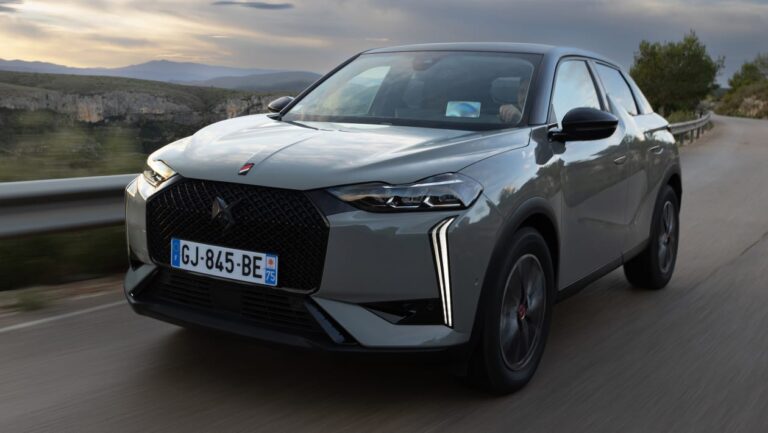Verdict
Despite the new car market’s push towards EVs, our preferred DS 3 still comes with a petrol engine. Representing far greater value for money, the punchy and relatively refined PureTech 130 continues to offer a unique take on the small SUV formula. A Ford Puma is better to drive, and a Peugeot 2008 more practical, but the DS 3 isn’t without charm. Just make sure to avoid the pricey range-toppers.
Small crossovers are all the rage right now, and have been for while. In some cases, car makers have ditched entire product plans to focus on SUVs; a raised ride height seems like a licence to print money.
And while DS’s efforts in this area of the market haven’t set the world alight, its entry model offers a unique take on the compact SUV formula. We have already driven the pure-electric DS 3 E-Tense, but at more than £40k as tested, this lower-spec petrol version should prove a more affordable option.
DS still thinks – at least for the time being – that the two PureTech petrol engines will account for the lion’s share of DS 3 sales. The cheapest PT 100 comes with a manual gearbox but is only available in most basic Performance Line guise. It’s the more powerful auto-equipped version we’re focusing on here.
The turbocharged PureTech 130 is an engine we’re very familiar with. It features in a range of cars – everything from the Peugeot 308 to the Citroen C5 X, plus everything in between. In something as modest as the DS 3 it strikes a good balance of performance and efficiency, feeling punchy enough most of the time, without the higher running costs of a more powerful motor.
In general, despite offering no electrification or mild-hybrid assistance, the petrol DS 3 feels very similar to the E-Tense to drive. It’s relatively light on its feet, with soft, compliant suspension and reasonable refinement. It isn’t the most engaging small SUV, however; the Ford Puma sets the benchmark in this class, but even the Peugeot 2008 with which the DS shares its basic platform feels sharper to drive.
Of course, the biggest difference between the E-Tense and this PureTech variant is the powertrain. The 128bhp three-cylinder unit revs cleanly, and emits a surprisingly sporty sound even at idle, but it can’t match the electric car’s smooth, quiet road manners – not helped by the dimwitted eight-speed automatic gearbox. The transmission is fine at town speeds, but its slow reactions are more noticeable the faster you go, and the more you ask of the car.
But even with a relatively small 44-litre fuel tank, the petrol car almost doubles the EV’s official range. This, in spite of the fact DS claims the PT 130 will return just 42.8mpg and emit 148g/km of CO2; far from class-leading and not particularly appealing to those looking to run a small SUV like this as a company car. A Nissan Juke – with its newer hybrid powertrain – can officially manage more than 55mpg, with far lower emissions, too.
Elsewhere, this petrol model benefits from many of the same updates as the E-Tense, including the subtly tweaked front end, redesigned rear, and refreshed cabin. Every car gets a digital instrument cluster and 10.3-inch touchscreen display, though you’ll need to upgrade from Performance Line to Performance Line+ to get DS’s upgraded Iris infotainment system including 3D navigation and voice recognition. You can still use the standard-fit Apple CarPlay or Android Auto for mapping, regardless of which trim you choose.
We’d go for one of these more affordable specs; the high-end Rivoli and Opera cars make the DS 3 difficult to recommend – even when mated to one of the cheaper petrol engines. Performance Line, in addition to the technology listed above, brings alloy wheels, Alcantara interior trim and keyless start, while the Performance Line+ (+£2,000) adds larger 18-inch wheels, that upgraded media set-up, and keyless entry.
Rivoli swaps our car’s black trim for chrome, while also ditching the Alcantara in favour of Basalt Black leather. Opera boasts everything from heated, massaging front seats, wireless phone charging and a head-up display, to a reversing camera and DS’s Advanced Safety Pack. Worthwhile extras, but difficult to justify on a car such as this.
Pleasingly, fit and finish doesn’t suffer significantly in lower-spec models like ours. The Alcantara trim on the dash has the potential to hide a multitude of sins, while the standard-fit seats and leather-wrapped steering wheel do little to justify the higher starting price of the top-end trims.
| Model: |
DS 3 Performance Line+ PureTech 130 Auto |
| Price: | £30,500 |
| Engine: |
1.2-litre 3cyl turbo petrol |
| Power/torque: | 128bhp/230Nm |
| Transmission: |
Eight-speed auto, front-wheel drive |
| 0-62mph: | 9.2 seconds |
| Top speed: | 124mph |
| Fuel economy: | 42.8mpg |
| CO2: | 148g/km |
| On sale: | Now |
Now read our review of the all-electric DS 3 E-Tense…


